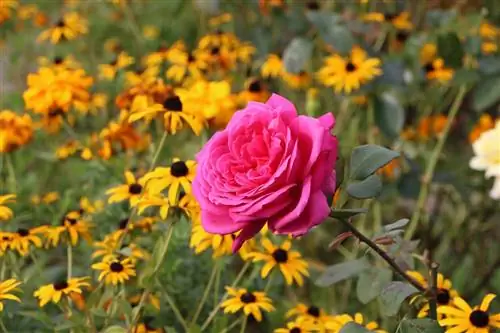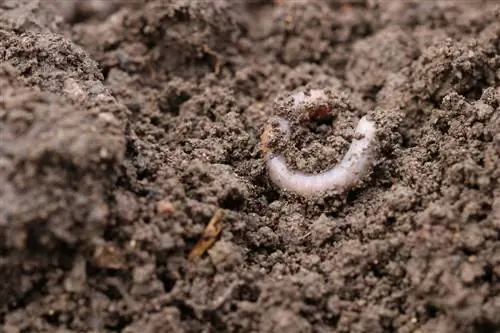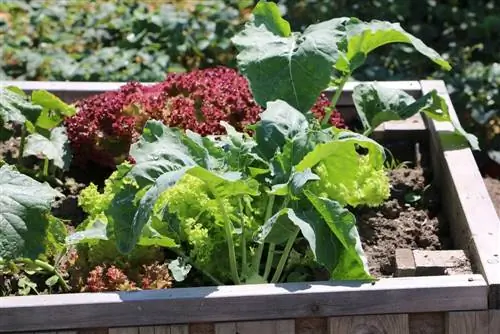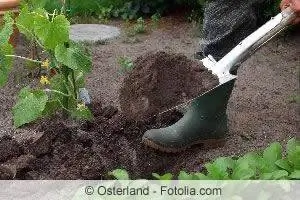- Author admin [email protected].
- Public 2023-12-17 03:39.
- Last modified 2025-01-24 12:45.
Your own vegetable garden is the perfect basis for supplying he althy, home-grown vegetables. However, there are a few important factors to consider when planning the vegetable beds so that gardening is quick and easy. Above all, preparing the beds and soil is an extremely important step, even before planting the vegetable garden for the first time.
Planning
So that the vegetable garden can be worked and harvested well, it not only needs sensibly laid out beds, but also practical areas for the various work processes. In addition, watering should not be underestimated, as vegetable beds require significantly more irrigation water than a conventional ornamental garden. The number of family members to be fed plays a crucial role in the size of the beds. However, if space is relatively limited, vegetables, fresh herbs and salads can also be grown in small areas. In this way, the menu either consists entirely of the seasonal products from your own harvest or is supplemented by them.
- Surface, shape and border can be designed according to personal preferences
- Make sure vegetable crops are homogeneous
- Plan storage areas and garden sheds for equipment
- Create a compost site nearby
- If there is enough space, build a greenhouse and cold frames
- Arrange water connection in a central location
- A nearby well is ideal
- Approx. 100-150 square meters of bed space is enough for a family
- Potato cultivation is significantly more land intensive
Create beds and paths
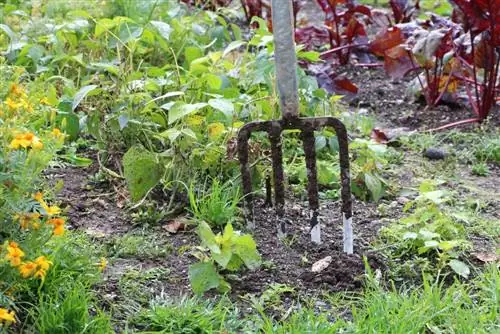
Opinions differ when it comes to the shape of the beds, square bed borders are quite classic. However, as a result of permaculture and biodynamic cultivation, naturally formed cultivated areas are becoming more and more common. If the bed is too wide, it will be difficult to access during harvesting and care. That's why it makes sense to create paths in the garden bed so as not to damage the soil structure.
- Make sure the location is sunny and sheltered from the wind
- Rectangular and square beds are common
- The ideal length and width is approximately 0.80-1.2 m
- Spiral-shaped borders are based on natural microcosms
- Narrow beds are ideal to make accessibility easier
- Divide areas between low-consuming, medium-consuming and heavy-consuming varieties
- Set up wooden boards as a fence to protect beds from predators
- Create paths in the shape of a cross
- Wide main path so that you can drive along it with a wheelbarrow
Prepare the floor
With your own vegetable garden, you can better control the quality of the products and rely on organic cultivation without toxins. In order for the sown vegetables to develop optimally, it is important to prepare the soil correctly. The most important thing is the nutrient content of the soil so that the vegetables can grow and thrive. That's why no weeds are allowed to grow in the garden bed, as they deprive the soil of many nutrients and vital moisture. Caution is advised when digging, as excessive and deep digging damages the soil life.
- Prepare soil before the gardening season
- Start in late February or early March, after the strongest frost
- Completely remove weeds, stones and old plant material
- Dig the soil carefully, about spade deep
- Enrich extremely nutrient-poor soil
- Apply compost and/or fertilizer
- Determine the pH value of the soil and adjust if necessary
loose up the soil
The looser the soil, the better light, air and heat penetrate into it. So that the roots of vegetables can develop optimally, well-ventilated soil is also important. In this way, the roots can penetrate deeper layers of soil much more easily and thus better absorb the required nutrients that are stored there. In addition, the soil should have sufficient capacity to store water so that it can easily survive a temporary dry period. Thanks to strong plant roots, the harvest is guaranteed to be successful.
- Carefully loosen and ventilate the garden soil
- A garden claw is ideal for the loosening process
- Alternatively, you can also use a digging fork, rake and rake
- Use only clean and sharp garden tools
- Proceed carefully to protect microorganisms and small creatures
- Loosen extremely firm and clayey soil at the end of autumn
Tip:
Planting substrate with coconut fibers is ideal for enriching compacted soils, as its loose structure positively promotes root development.
pH value in soil
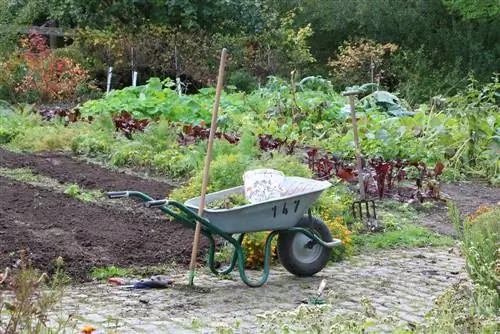
The pH value of the soil is extremely important for successful sowing and harvesting. To determine this, special measuring devices are available from specialist retailers. In this way, the pH value can be determined regularly, quickly and easily. Most vegetables prefer neutral pH levels in the soil. If the soil is too acidic or too alkaline, it should be treated accordingly. In addition, constant new planting leads to an adverse change in the pH value. In addition, watering and heavy rainfall cause elementary components in the soil to be washed out.
- Be sure to measure the pH value before sowing
- Ideal is a neutral pH value in the range of 7
- If the value is below 6.5, the soil is too acidic
- Then enrich with lime or bas alt flour
- If values are above 7.5, the soil is too alkaline
- Then mix in the peat or granite flour
- Alternatively, adding coffee grounds also helps
Fertilization & Compost
Vegetables grow much better in nutrient-rich soil. It is therefore advisable to enrich the soil with compost and fertilizer before sowing. These contain a variety of important nutrients and sustainably promote the growth process. In addition, soil organisms are also activated by mixing in compost and natural fertilizer. Until sowing, these microorganisms and small creatures release vital nutrients for the young plants.
- Enrich cultivated areas gently with organic fertilizer
- Create a compost heap from pure kitchen and garden waste
- Only use humus from the compost from the previous garden season
- Use the lower layer of compost, remove the upper layer first
- This contains many microorganisms and useful earthworms
- Sufficiently seasoned horse manure is also well suited
Sowing
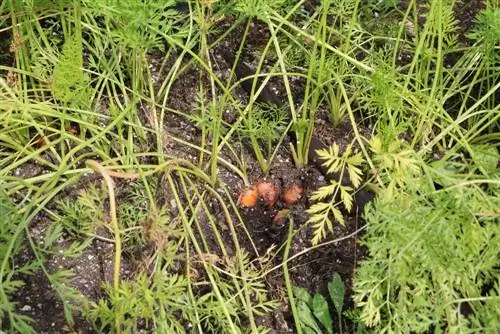
If the soil structure is fine and even, then the seeds can be better controlled and placed in the ground at the required depth. In this way, the fine soil particles are washed around the seeds during subsequent watering. In this way, the seeds receive sufficient contact with the soil and can develop well. However, it depends on the vegetable culture whether they can be sown directly into the bed. Some types of vegetables need to be preferred to young seedlings in advance.
- Sowing after the last frost nights in May
- Smooth the soil, water it and then press it lightly with a wooden board
- Spread seeds in sufficient quantities
- Don't use too much seed, make sure there is enough distance
- Seed tapes are practical, with vegetable seeds in paper tape
- Draw grooves in the ground first
- Then place seed tapes in the substrate, paper will decompose later
- Next, cover lightly with substrate
- Soak well at the end
- Watering can with attached watering spout is ideal for particularly fine drops


